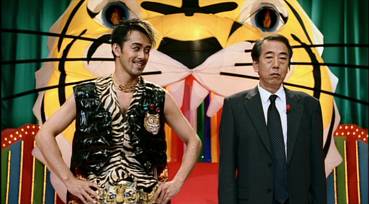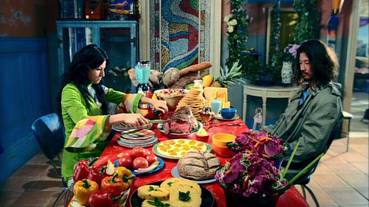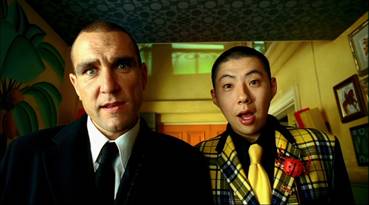| |
"A whacked-out surrealist comedy from the farthest reaches of the imagination, coming on like a fantastical version of Pulp Fiction if directed by Takashi Miike while tripping on acid." |
| |
From the promotional material for Survive Style 5+ |
It's
rare that I quote from a film's pre-release publicity unless
I'm going to mock it, but I have honestly not come across
a better summary of the many bizarre but genuine pleasures
of Sekiguchi Gen's extraordinary feature debut than that snippet above. Lest you be misled by the drug trip reference, I
should point out that the pacing is usually quite sedate and
Sekiguchi resists the machine-gun filmmaking that his
background as a commercials director might suggest. But
in every other respect this is as strange and wonderful
and inventively off-the-wall a film as you'll see all year.
Well, any year, actually.
It's
difficult to know quite where to begin with Survive
Style 5+, as even the title (and this is the title,
not an English translation or creative interpretation) is
about ten hops from self-explanatory and provides no clues
to just what you are in for. Like the above-mentioned Pulp
Fiction, there are multiple, occasionally intersecting
storylines, a couple of which are built around criminal
activity, but that's where all comparisons end. Survive
Style's reality, if you can call it that, is positioned
somewhere between the everyday and the fantastic, a version
of modern Japan that appears to have bounced through a worm
hole and picked up sizeable dollops of 60s America and 70s
London en route, as well as a juke box with an international
time-warp function.

A
not-so quick introduction to the storylines and characters
should help you decide if this is for you. The film opens
on wealthy but emotionless Masahiro (Asano Tadanobu) pondering in voice-over
the decision to kill his wife Mimi (Reika Hashimoto). It's a murder that he has already committed
and that he completes by dropping her body in a woodland grave and,
after noticing a facial twitch, repeatedly beating her head
with a spade. On returning home, however, he finds her sitting
at the kitchen table as if nothing has happened. After cooking
him an enormous breakfast, which he heartily consumes, she
proceeds to beat him senseless with the strength and determination
of a sadistic, ninja-fueled Terminator.
Self-absorbed advertising
executive Yoko (Koizumi Kyōko), meanwhile, takes repeated inspiration from
everyday observations to create cheesy new commercials in
her head, noting the ideas for future reference on a small
tape recorder that is her only true companion. When her
mind is not on work she contemplates the idea of taking
out a contract on her boorish boyfriend, cocksure celebrity
hypnotist Aoyama (Abe Hiroshi), whose show the cheery but financially
strapped Kobayashi family have just procured tickets to
see. At the same time three young and inept house-breakers who are named after the actors who play them – Tsuda (Tsuda Kanji),
J (Jai West) and the impossibly goofy Morishita (Morishita Yoshiyuki) – are touring the neighbourhood
in search of amusement and discussing which hand they masturbate
with, while on an arriving plane an air hostess is loudly
interrogated by an English hit man (Vinnie Jones) and his Japanese interpreter Katagiri (Arakawa Yoshiyoshi) about her true function in life.
And
this is just the opening few minutes. As the stories progress
and intersect, the bizarro factor gets turned up several
notches. At Aoyama's show, the front seated Kobayashi family
are selected for the million yen challenge, a chance to
get rich if Aoyama fails to hypnotise the family's father
Tatsuya (Kishibe Ittoku). No sooner has Tatsuya been convinced that he's
a bird than the English hit man and his translator walk on stage and kill the hypnotist, fulfilling a contract taken
out by Yoko. With Aoyama dead and unable to reverse his
hypnotic triumph, the distressed Kobayashis return
to their house with their father in permanent bird mode,
his body crouched, his arms dangling like wings, a regular
'pok-pok' his only method of communication. It is their
house, however, that Tsuda, J and Morishita have raided
earlier, and having found nothing of value they have hung around
there to play cards. Surprised by the family's return, Morishita
and J hide in the wardrobe, where for the second time that
evening J finds himself being lovingly ogled by his young
companion. Masahiro,
meanwhile, has managed to re-kill and re-bury his wife,
but she returns again, sending him fleeing from the house
and into the offices of a certain contract killer...

It
is Masahiro's story that provides the film with its most outrageously
trippy scenes, as his wife repeatedly returns from the
grave to assault him in increasingly bizarre ways. She
flies down from the ceiling when he lays on his bed, breaths
fire at him (and lighting his cigarette in the process)
after he has attempted to burn her corpse, and following
his misguided attempt at dismemberment, she chases him around
the house launching her severed limbs at him like bazooka
shells. Much of this is genuinely and deliberately hilarious,
and the humour is fueled by a succession
of oddball characters and traits, which include an executive who interrupts
meetings to take trivial calls from his wife, Yoko's
hissy snigger and imagined commercials (which are played
out in full and are frankly no exaggeration of the Japanese
commercial style), the teacher who passes brutally honest
judgment on the paintings of her young pupils, and the motorcycle
cop who taunts Masahiro with tales of a ghostly policeman and
then laughs hysterically at his own waggish humour. And
this is just a sampling.
What
really catches you out in the later stages is the layer
of thoughtful humanity that creeps into the stories,
giving the strangeness real purpose as characters discover
inner truths about their own lives, resulting in touchingly
affecting scenes that allow them to reflect on the true
nature of love and loss and how it affects them and those
around them. Nowhere is this better realised than in the
reaction of the Kobayashi family to Tatsuya's fate – while
his wife Misa (Asō Yumi) and his teenage daughter Kaho (Kanjiya Shihori) dismay for his and their future,
young son Keiichi (Kamiki Ryūnosuke) is not in the least bit fazed by his father's transformation and loves him for what he is rather than pining for what was. Not yet set
in his ways and opinions, he adapts to change and embraces
it, and after his father's abortive attempt to fly lands
him flat on his back on the lawn, Keiichi accompanies him to the park to
leap off of a shallow bank and roll down the grass with
him, his voice-over here providing a wisdom that other characters
learn only by more drastic means.
Visually
and aurally this is like no other Japanese film I've ever
encountered, with the costume and set design alone
worthy of study and celebration, the recognisably modern
thoroughly infused with an almost hallucinogenic 60s psychedelia
that crawls across every wall and into every corner and
prop of some of the key interior locations. It even infests
the vehicles, from the flowered exterior of Masahiro's old Buick
to the tacky treasure trove that is the interior of the burglars'
VW camper (both of them vehicles whose heyday has passed,
of course). This
cultural borrowing extends to the soundtrack, with the dialogue
intermittently peppered with English words and phrases that
characters use as statements of status in their own hierarchy
of cool, and a music track littered with lesser-known western
rock numbers. There is the sense that some of these have
been selected in part because of the language in their lyrics,
a slightly obvious attempt at bad boy image creation on
the part of Sekiguchi, but they are nonetheless well chosen
and integrated into the action. They are even used for occasional comic effect,
such as when we catch the clean-cut Kobayashi family headbanging
in unison and shouting "Fuck! Fuck!
Fuck! Fuck!" along with the lyrics of a song blasting out of the car radio. The melding of
elements is so complete that despite the language and setting,
there is little here that is culturally specific to Japan
at all, save for Yoko's mineral water commercial, which
is structured around a well-known Japanese fantasy creature
but will probably play as completely abstract outside of
its home turf.

Further
enhancing the film's already established (and growing) cult
status is a cast that brings together the old, the new and
the frankly unexpected. Man of the moment Asano Tadanobu
(beard aside, looking exactly as he did in Tsukamoto's Vital,
made the same year) is typically enigmatic as Masahiro, Sonny
Chiba shakes off his warrior image to accept silly phone
calls from his wife as company executive Kazama, and fellow
veteran Kishibe Ittoku (most widely known here for his roles
in Takeshi Kitano's Violent Cop and Zatoichi),
is hardly playing to type as Tatsuya, spending most of the
film clucking and perched like a bird and at one point almost
naked in a giant microwave, imagining himself being cooked
for the family meal. Kizumi Kyoko, a recording artist of
some repute in Japan, plays Yoko with a lovely blend of
self-centred contempt and almost childish glee at her own
imaginings, but the biggest surprise has to be the casting
of Vinnie Jones (yes, that Vinnie Jones) as the English hit man,
doing the same old hard nut act as usual but nonetheless
just right for a role that is so deliberately out of step
with its surroundings.
All
in all, Survive Style 5+ is a delirious
ride, a wildly imaginative, funny and visually eye-popping
experience that gradually reveals a surprising underlying
complexity and sense of purpose. My first viewing was with
friends after two days of drinking and movie watching and
it went down a storm, my second was in sober isolation and
it played just as delightfully. The publicity will tell
you that it's like nothing you'll have experienced before
and for once they're actually right. You just have to see
it. Oh, and don't let anyone tell you what happens in the
final scene. Suffice to say there isn't a person I've shown
it to who hasn't arrived at the credits with a beaming smile
on their face.
A
film with this level of colour and detail demands a top
quality transfer and it gets it, Manga's anamorphic 1.85:1
transfer doing full justice to the film's astonishing production
design and vivid use of colour. Contrast and detail is impressive
throughout, and even the darker scenes show no real evidence
of unsightly compression artefacts. A very nice job indeed.

Matching
the visuals are three soundtrack options – the Dolby stereo
2.0 track is no slouch, but the 5.1 and DTS tracks are the
only way to go, boasting good separation, an excellent dynamic
range and a fair amount of LFE punch when required. Of the
two, the DTS definitely has the edge.
The
Making-Of Featurette (28:22)
appears to have been sourced from a Japanese release and
is a must for anyone who enjoyed the film. Pretty much all
of the main cast members are interviewed: Kishibe Ittoku
talks about playing a bird; Sonny Chiba remarks how quiet
Sekiguchi is compared to directors like Fukusaku Kenji;
Koizumi Kyoko muses on the challenges of playing a lead role;
Abe Hiroshi reveals that the dancing scene was the hardest
part of playing Aoyama; Vinnie Jones (speaking in English
and subtitled in Japanese) thinks Arakawa Yoshiyoshi will
steal the movie playing his translator; and Jai West,
Morishita Yoshiyuki and Tsuda Kanji (who play the three burglars)
discuss the positive on-set atmosphere. All of this plays
in voice-over behind always interesting behind-the-scenes
footage, none more surprising than the camera attached to
a radio-controlled helicopter for the aerial shots. There's
plot revealing stuff in here, so this is one for after the
feature.
The
Trailer (1:31) gives a fair flavour
of the film's style and announces itself as "A Japanese
film unlike any other." No arguments here.
There's
also Manga Attacks (6:28), a montage
of extracts from other Manga titles set to rock tracks.
If
it's possible for a film to be both complete barmy and yet
thoughtful and smart, strangely retro and yet hip and modern,
violently cruel and yet tenderly insightful, then Survive
Style 5+ is it. Everyone I‘ve shown it to
appears to have loved it. I love it. Whether I can justify it as a great
film is uncertain, but it's bloody marvellous outsider cinema,
which is all that really counts here, and it's also more
inventive, more original and more fun than almost anything
I can imagine seeing this year. Manga's DVD showcases the
film nicely, and though I could happily have watched another
hour of making-of footage, what is included does the job
well. This is already one of my favourite releases of the
year. Very highly recommended.
The Japanese convention for surname first is used for all Japanese names in the review except those that have adopted Western monikers, specifically Sonny Chiba and Jai West.
|